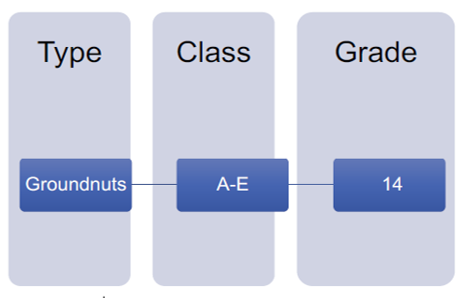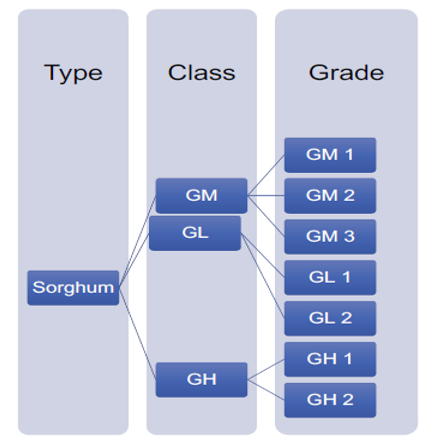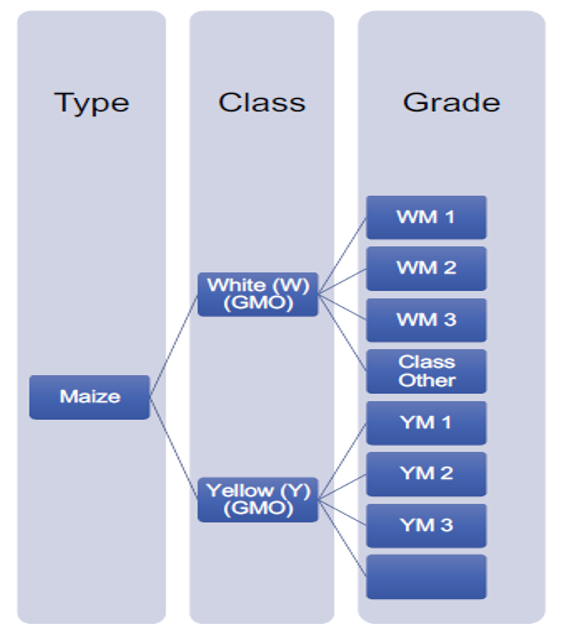Grading factors for various grains, oilseeds and dry beans are prescribed by law and are summarised in the table below.
|
Ground Nuts
|
Standards for GRADES A consignment of groundnuts must comply with the following requirements: 1. Be free of the following: Musty, sour or any other undesirable odour. Live insects. A substance which renders it unfit for human or animal consumption. Chemical residues that exceed the prescribed MRL’s. 2. Free from seeds of Ricinus communis and not contain more poisonous seeds, as well as total aflatoxin and aflatoxin B1, as prescribed by the Foodstuffs, Cosmetics and Disinfectants Act, No 54 of 1972. 3. Have a moisture content of not more than 7%. |
|
Barley
|
Standards for GRADES A consignment of barley must comply with the following requirements: 1. Be free of the following: Musty, extreme mould infected, sour and rancid foreign matter. Any undesired odour, taste or colour not typical of non-damaged and sound barley. Any animal rests; dead rodents or birds and dung. Live insects. Smut infection. Toxin, chemical or other substances making it unsuitable for human and animal consumption. 2. May not exceed permissible deviations of aflatoxin or more poisonous seeds permitted of the MRL’s prescribed for agricultural remedies in terms of the Foodstuffs, Cosmetics and Disinfectants Act No 54 of 1972. 3. Have a moisture content not exceeding 13%. |
|
Sorghum
|
Standards for GRADES 1. Consignments of all grades of sorghum must contain none of the following: Anything that makes sorghum unfit for human or animal consumption. Live insects inside or around sorghum or containers (insect-contaminated sorghum can be fumigated and inspected again). Black discoloration due to smut without 10 or more smut balls or portions thereof per 100 gram sorghum. No more poisonous seeds per kg than prescribed by the Act 54 of 1972. 2. Free of mouldy, sour or undesired smells. 3. Moisture content must not be more than 14%. 4. Contain no chemical residue that exceeds the MRL, except where the MRL of the country exported to is higher or lower. 5. Not exceed the maximum percentage of permissible variances of each grade. 6. The presence of purple stains on the outside covering must not be taken into account. |
|
Standards for Classes |
||
|
GM Sorghum Comply with the standards for the grades of GM sorghum. Consists of malt sorghum without dark testa. Is a GM cultivar as determined in the cultivar list. |
GL Sorghum Comply with the standards for the grades of GL sorghum. Consists of malt sorghum without dark testa. Is a GL cultivar, but cannot be classified as a GM grade. Is a GL cultivar as determined in the cultivar list. |
GH Sorghum Comply with the standards for the grades of GH sorghum as listed. Consists of malt sorghum with a dark testa. Is a GH cultivar as determined in the cultivar list. |
|
Canola
|
Standards for GRADES A consignment of Canola must comply with the following requirements: 1. Be free of the following:
2. Contain no more poisonous seeds or ergot sclerotia than permitted in terms of the Foodstuffs, Cosmetics and Disinfectants Act, No 54 of 1972. 3. Have a moisture content of not more than 8%. |
|
Soya Beans
Standards for CLASSES A consignment of soya beans must comply with the following requirements:
|
Standards for GRADES A consignment of soya beans must meet the following requirements. 1. Not contain any of the following: Glass, metal, coal or animal manure. Not more poisonous seeds as permitted in terms of the Food, Cosmetics and Pesticides Act (No 54 of 1972). Live insects in soya beans, on bags or containers (contaminated soya beans can be fumigated and inspected again). Anything that makes soya beans unfit for consumption by humans or animals. 2. Be free of mouldy, sour, khaki-bush or other undesired smells. 3. Contain no chemical residue that exceeds the prescribed MRL, except where the MRL of the country exported to is higher or lower. 4. Moisture content of soya beans my not be higher than 13%. 5. Not exceed the maximum percentage of permissible variance of the grade. |
|
Wheat
Grading standards The requirements for wheat consignments are: Graded as Grade 1, Grade 2, Grade 3, Grade 4 or Utility grade if the nature of the variances in the consignment do not exceed the percentage as specified against the specified percentage in the specified table. The minimum hectoliter mass is: Grade 1 to Utility grade: 77 kg, 76 kg, 74 kg and 70 kg, respectively. The minimum falling number of not less than 250 seconds for: Grades 1,2 and 3 (Grade 4 and Utility grade are a minimum of 200 and 150 seconds respectively). Still acceptable if not more than 30 seconds lower (that is, 220 seconds). Requirements for minimum protein content: Grades 1,2,3,4 and Utility Grade, should respectively have a minimum protein content of 12, 11, 10, 9 and 8 percent. |
Standards for all CLASSES of wheat A consignment of wheat must comply with the following requirements: Be free from any poisonous substance, chemical, or other substances that could make wheat unfit for humans or animals. Not contain more poisonous seeds than what is allowed in terms of the Food, Cosmetics and Pesticides Act (No 54 of 1972). Be free from smells, taste or colour that are not typical of undamaged wheat. Be free from other grain that is mould infested, sour or rancid, as well as foreign and other items. Contain no chemical residues that exceed the prescribed MRL, expect where the MRL of the country exported to is higher or lower. Does not contain more than 10 micrograms per kilogram aflatoxin of which may not be more than 5 micrograms per kilogram aflatoxin B1, except where the maximum aflatoxin levels could be lower of the country exported to: Be free of live insects in, on or around wheat, in bags with wheat, or containers. Insect-contaminated wheat can be fumigated and inspected again. Be free from “stinking smut infection”. May not have a moisture content of more than 13%. |
|
Maize
|
Standards for GRADES A consignment of both classes of maize must: 1. Contain none of the following: Glass, metal, coal or animal manure. Anything that makes maize unfit for human or animal consumption. Not more poisonous seeds as allowed in terms of the Food, Cosmetics and Pesticides Act (No 54 of 1972); that is Argemone Mexicana, Convolvulus spp, Ipomoea purpurea, Lolium temulentum, Xanthium spp (all 7 seeds per kg); and Crotalaria spp, Datura spp or Ricinus communis (all only 1 seed per kg). Live insects in maize, on bags or on containers (insect-contaminated maize can be fumigated or inspected again). No stones bigger than 6,35 mm (remove with round hole sieve) and also no more than one gram stones (smaller than 6,35 mm) per 10 kg. 2. Not exceed the maximum percentage of permissible variances of every grade. 3. Be free of mouldy, sour or any other undesired odour. 4. Contain no chemical residue that exceeds the Maximum Residue Level (MRL), except where the MRL of the country exported to is higher or lower. 5. Moisture content of maize may not be higher than 14 percent. |
|
Standards for CLASSES |
|
|
White Maize A consignment for white maize must comply with the following requirements: The standards for one of the four grades of white maize. Within permissible variances for different grades. Kernel (endosperm) of maize is white. |
Yellow Maize A consignment of yellow maize must comply with the following requirements: The standards for one of the four grades of yellow maize. Within permissible variances for different grades. Kernel (endosperm) of maize is yellow. |






